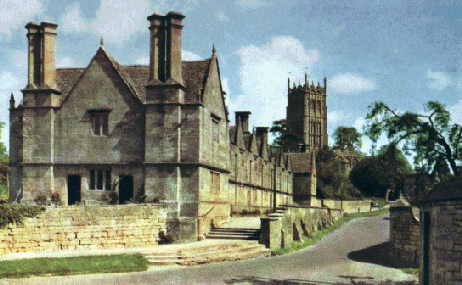The name Keen is of Anglo-Saxon origin, coming from OE cene (ME kene) = brave, bold, fierce; wise (which gave our
adjective, "keen"). It came into use as a name in two ways: [1] as a shortening of such OE names as Cenwine
(e.g., Ricardus filius Kene, 1188, Devonshire); [2] use as an attribute (e.g., Richard le Kene, 1297, Oxfordshire).
The earliest record of our family of Keens is from Stow on the Wold in the Cotswold Hills of Gloucestershire. The
town occupies a hilltop site between the rivers Evenlode and Dikler. in earlier times this site was lightly wooded
with beech, ash, and whitebeam, with an understorey of holly, hawthorn, bramble and bracken; but these woods (the
Wold) are now long gone.
 |
Today, Stow is a town of grey limestone buildings lying amid fields of barley, with little to stop the penetrating
winds that sweep across its great hill. "Stow on the Wold, where the winds blow cold," as the local people
say.
Right: The Almshouse, Chipping Campden.
Chipping Campden is one of the jewels of the Cotswolds, with many beautiful stone buildings, mellowed with age;
notably the pillared Market Hall and 17th century almshouse, built by the first Viscount Campden.
The town owes its existence to several "trackways" that cross over the Cotswolds.
The oldest was the track running east-west, coming from Naunton and going on to Adlestrop. it was a major branch
of the pre-historic Cotswold Ridgeway. The other main branch of it passed further north, crossing the ridge at
Broadway Hill (between Broadway and Chipping Campden). Together they formed part of the major Palaeolithic and
Iron Age route across England from Bristol Avon to the Humber.
The second, the north-south road coming from Bourton on the Water and going on to Donnington, was built by the
Romans as part of the Fosse Way which ran from Bath to Lincoln.
The third trackway entered the Cotswolds near Chipping Campden and ran along the north-south ridge, passing near
Blockley and Sezincote, through Stow, and from there followed the upland road the Church Icomb and Idbury and then
to Bampton.
This route was a medieval saltway; one of several trackways through the Cotswolds used in transporting salt during
the Middle Ages. It probably followed a path trodden out along the ridge in much earlier times.
from its earliest beginnings, Stow has been a market town supplying the surrounding villages and farms, as well
as providing food and lodgings for travellers.
In 1107, Henry I decreed that the town (then called Edwardstow) should have a weekly market.
During the Middle Ages wool became the major produce of the Cotswolds; the hills almost becoming one large sheepwalk.
Because of there location on major roads, three towns became market centres in which sheep fairs were held; they
were Cirencester, Northleach, and Stow on the Wold. In addition Stow became the horse fair town of the Cotswolds.
Echoes of its former self can still be heard in the colour and cadence of the Cotsall and Romany tongues, as bargains
are struck between dealer and buyer. It appears, too, that our Keens had a deep knowledge of horses.
Until the mid-twentieth century the comfortable, old-fashioned, inns were filled on market and fair days with farmers,
and their talk was all of horses, cattle, sheep and pigs, and the price of barley. Recently it has attracted more
and more tourists and sightseers.
The town grew up about the wide marketplace, being fortunate in having this flat space on its hilltop. The picturesque
alley-ways leading off it came later, as the town grew. The marketplace, enclosed on four sides by shops and houses,
and with a great elm tree for shade, a small town hall in its centre, is still the heart of Stow.
The tower of St Edward’s Church is visible above the trees for miles around, although it does not dominate the
town itself. St Edward’s was originally founded about 870, and has been reconstructed several times since. In the
fifteenth century its great tower was built with funds provided by the town’s wealthy wool merchants.
The earliest records of our family of Keens are from the register of St Edward’s Church in Stow on the Wold; a
register which starts in 1558, although the initial records are sparse, and do not become comprehensive for more
than another 100 years.
 |
Left: Worcester Cathedral. |


